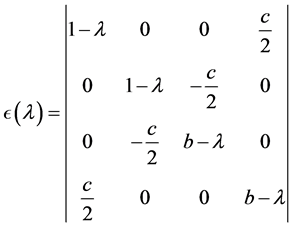Journal of Modern Physics
Vol.08 No.04(2017), Article ID:74736,11 pages
10.4236/jmp.2017.84032
Exact Propagator of a Two Dimensional Anisotropic Harmonic Oscillator in the Presence of a Magnetic Field
Jose M. Cerveró
Department de Fsica Fundamental, Facultad de Ciencias, Universidad de Salamanca, Salamanca, Spain

Copyright © 2017 by author and Scientific Research Publishing Inc.
This work is licensed under the Creative Commons Attribution International License (CC BY 4.0).
http://creativecommons.org/licenses/by/4.0/



Received: January 25, 2017; Accepted: March 13, 2017; Published: March 16, 2017
ABSTRACT
In this paper we solve exactly the problem of the spectrum and Feynman propagator of a charged particle submitted to both an anharmonic oscillator in the plane and a constant and homogeneous magnetic field of arbitrary strength aligned with the perpendicular direction to the plane. As we shall see in the beginning of the letter, the Hamiltonian, being a quadratic form, is easily diagonalizable and the Classical Action can be used to construct the exact Feynman Propagator using the Stationary Phase Approximation. The result is useful for the treatment of quasi two dimensional samples in the field of magnetic effects in nano-structures and quantum optics. The presented solution, after minor extensions, can also be used for motion in three dimensions, and in fact it has been used for years in such cases. Also it can be used as a good exercise of a Feynman Path Integral that can be calculated easily with just the help of the Classical Action.
Keywords:
Quantum Mechanics, Path Integrals and Propagators

1. Introduction
The problem of quantum charged particles in the presence of electric and magnetic fields has always remained on target of any theoretical physicist who wishes to predict the behavior of one or a swarm of such particles imbedded in the structure of a solid. The exact solution in three dimensions has eluded these attempts for years. However, when the particles remain in a two dimensional solid, the problem of the exact solution becomes both feasible and possible. Experimentally, the last situation has only been possible to be realized until very recently in the laboratory thanks to the technological means that allow the experimentalists to produce quasi dimensional samples of metals and semi- metals. One can induce large magnetic behavior combining them with ferromag- netic 2D materials such as  and
and . Indeed we should also mention the recent discovery of Magnetic Graphene which falls in the class of these two dimensional samples when combined with the aforemen- tioned substrates. The propagator can also be used in three dimensions with some little arrangements. However, I restrict myself to the two dimensional case given the importance of two dimensional solids nowadays.
. Indeed we should also mention the recent discovery of Magnetic Graphene which falls in the class of these two dimensional samples when combined with the aforemen- tioned substrates. The propagator can also be used in three dimensions with some little arrangements. However, I restrict myself to the two dimensional case given the importance of two dimensional solids nowadays.
However, the stationary solution of a bounded Hamiltonian is only of academic interest as we would like to know the evolution of the particle inside of the two dimensional solid. This goal can only be achieved if we know the propagator of the particle(s) along the time and the properties that may or may not change in the sample: phase transitions from metal to semimetal or to an insulator phase, the behavior of the Anderson localization, the magneto-optics properties of the solid and the like. This wealth of physical effects can be studied if we know the Feynman propagator of the system and the help of computing algebraic calculus. The aim of this paper is to show that these results can be attained with little effort and a touch of elegance.
The problem of the exact solution of the Feynman propagator of the system simplifies a great deal with the help of the Stationary Phase Approximation that turns to be exact in the case of a quadratic Hamiltonians. In this paper, we use the most general two-dimensional Hamiltonian with magnetic effects provided by a magnetic field pointing in the perpendicular direction of the plane. The rest of the interaction is represented by anisotropic harmonic oscillators lying in the plane along perpendicular directions.
I would like to finish this Introduction with a set of References. The Feynman Path Integrals [1] are well known from a historical perspective [2] to an encyclopedic account with many examples [3] . Also this Quantum Mechanical problem has been partially treated many years ago in References [4] and [5] .
2. Quantum Mechanical Hamiltonian
The Hamiltonian described in the Introduction has the form:
 (1)
(1)
where  and
and  are the first order frequencies on each direction of the plane. The set of variables are well known in electromagnetic theory. One can select the following gauge for the magnetic vector that produces a constant magnetic field of arbitrary strength and perpendicular to the plane:
are the first order frequencies on each direction of the plane. The set of variables are well known in electromagnetic theory. One can select the following gauge for the magnetic vector that produces a constant magnetic field of arbitrary strength and perpendicular to the plane:
 (2)
(2)
and the Hamiltonian reads:
 (3)
(3)
with
 (4)
(4)
Obviously  is the strength of the constant magnetic field. Let us now call:
is the strength of the constant magnetic field. Let us now call:
 (5)
(5)
and we scale the position and momentum operators in a scale free way in the form:
 (6)
(6)
 (7)
(7)
Again, with this change of variables the Hamiltonian takes the form:
 (8)
(8)
that looks as a quadratic form that we can easily diagonalize:

where  and
and  are constants:
are constants:
 (9)
(9)
The non vanishing real roots of the quartic equation take the form:
 (10)
(10)
and multiplying the Hamiltonian by

or in a more tractable manner:

If one diagonalizes the isotropic harmonic oscillator in both cartesian and angular coordinates the Landau eigenlevels are labeled respectively by the quantum numbers 


Therefore the Hamiltonian exhibits a complete breaking of the magnetic degeneracy. This effect has nothing to do with the spin-orbit coupling as the spin degrees of freedom are absent from the Hamiltonian. It is in turn closely related to the Landau orbital coupling interacting with the magnetic field. The non trivial question of writing down the wave functions has been largely discussed in [6] and [7] . The interested reader is invited to address himself to these references.
3. Lagrangian Formalism and Construction of the Propagator
The Lagrangian of the system has the obvious form:

and now select a different gauge, but representing also a constant magnetic field in the perpendicular direction to the plane:

The change of gauge causes no problems in the final solution of the propagator as it was pointed out many years ago by Bialynicki-Birula [8] . The propagator and quantum amplitudes in general are invariant under a gauge transformation. In our case:

It is easy to find out the actual fom of


which vanishes for the isotropic limit. For a throughout and recent discussion on gauge independence of the propagator see reference [9] .
The Lagrangian looks now as:

and the Equations of Motion are:

where where 



where:

We shall name:







Next we shall be concerned with the evaluation of the classical action of the anisotropic net in the presence of a uniform and constant magnetic field. The various steps of the calculation are listed in Section 4 at the end of the paper. For the moment we shall be concerned formally with the action derived from this Lagrangian 

where we have used (16). Next we integrate by parts the terms 


The integral of the right hand side is trivially zero as it contains only the equations of motion (17). This property has been used in other contexts in reference [10] for the general case of kinetic energy plus an arbitrary potential depending just upon the coordinates. One finally founds:

and substituting the values of the coordinates and their derivatives one finally obtains the following expression for the action

The Amplitude of the Propagator is now calculated with the help of the VanVleck-DeWitt-Morette Determinant. As it is well known the form of the Determinant is:

where 

The result leads to:

Substituting 


and the propagator takes the final form:

where

The expressions for 





where 

variance of each packet. Although these projects for Master Thesis or Graduate Courses can be considered as a little cumbersome, they might attract the interest of the young physicists to the condensed matter field in which much of the research is being done nowadays.
4. The Main Result and Calculations with Useful Definitions of Interest
To obtain 



where the matrix elements and the determinant 
and the determinant takes the form:

Likewise one can easily calculate




The derivatives then take the form:




where:









Notice the interesting relationship:

The following constants have been defined in the body of the Paper as:



With these definitions the following expressions hold:





5. Conclusion
We have presented and fully solved the propagator of the anisotropic two dimensional harmonic oscillator in the presence of a constant magnetic field in the perpendicular direction of the plane. The solution is based on the Stationary Phase Approximation that is exact in this case as the Hamiltonian contains terms no more than quadratic terms. We believe this solution is most interesting today when a large amount of plane samples as grapheme with large mobility (large number of electrons per unit of area) are submitted to various both strong and constant magnetic fields.
Acknowledgements
This research has been carried out with the partial support of MINECO under the project MAT2013-46308-C2-1-R and JCyL Project Number SA226U13.
Cite this paper
Cerveró, J.M. (2017) Exact Propagator of a Two Dimensional Anisotropic Harmonic Oscillator in the Presence of a Magnetic Field. Journal of Modern Physics, 8, 500-510. https://doi.org/10.4236/jmp.2017.84032
References
- 1. Feynman, R.P. and Hibbs, A.R. (2010) Quantum Mechanics and Path Integrals. Emended Edition, Dover Books in Physics, McGrawHill, USA.
- 2. Brown, L.M. (2005) Feynman’s Thesis. World Scientific Pub., Singapore.
- 3. Kleinert, H. (2006) Path Integrals in Quantum Mechanics, Statistics, Polymer Physics, and Financial Markets. World Scientific Pub., Singapore.
- 4. Kokiantonis, N. and Castrigiano, D.L.P. (1985) Journal of Physics A: Mathematical and General, 18, 45-47.
https://doi.org/10.1088/0305-4470/18/1/015 - 5. Davies, I.M. (1985) Journal of Physics A: Mathematical and General, 18, 2737-2741.
https://doi.org/10.1088/0305-4470/18/14/024 - 6. Sebawe Abdalla, M. (1990) Nuovo Cimento, 105B, 1119-1129.
- 7. Dippel, O., Schmelcher, P. and Cederbaum, L.S. (1994) Physical Review A, 49, 4415-4429.
https://doi.org/10.1103/PhysRevA.49.4415 - 8. Bialynicki-Birula, I. (1967) Physical Review, 155, 1414.
https://doi.org/10.1103/PhysRev.155.1414 - 9. Bandrauk, A.D., Fillion-Gordeau, F. and Lorin, E. (2013) Journal of Physics B: Atomic, Molecular and Optical Physics, 46, Article ID: 153001.
https://doi.org/10.1088/0953-4075/46/15/153001 - 10. Dittrich, W. and Reuter, M. (1996) Classical and Quantum Dynamics. Springer, New York.
- 11. Urrutia, L.F. and Manterola, C. (1986) International Journal of Theoretical Physics, 25, 75-88.
https://doi.org/10.1007/BF00669715 - 12. O’Connell, R.F. and Zuo, J. (2003) arXiv:quant-ph/0311020 v1.



















